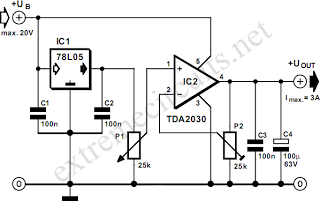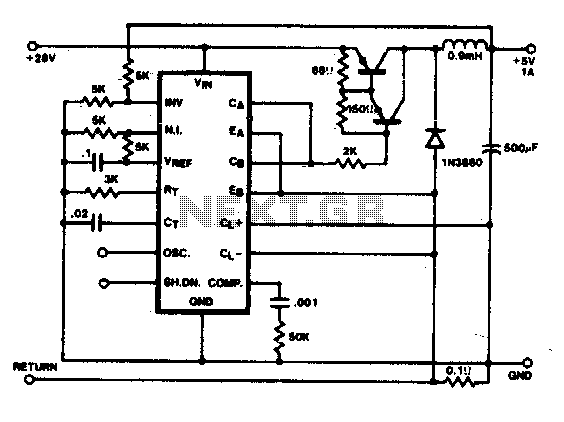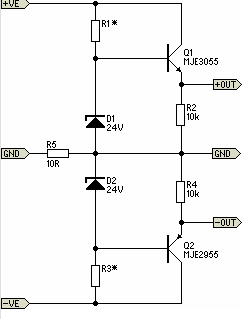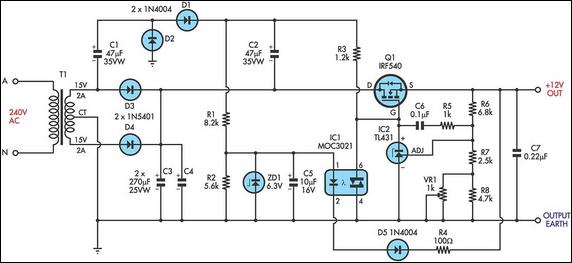
Adjustable 3 Ampere Regulator

By combining a standard 78L05 voltage regulator with an integrated audio amplifier, specifically the TDA2030, it is possible to construct a simple yet effective adjustable voltage regulator. This regulator can output a voltage adjustable up to 20 V and handle a maximum current of 3 A. The TDA2030 features built-in thermal and short-circuit protection, making this adjustable regulator robust. The circuit design, as depicted in the schematic, is notably straightforward. Apart from the two integrated circuits, the regulator comprises only two potentiometers and several capacitors. The adjustment process begins with setting potentiometer P1 to its maximum position (wiper towards the 78L05) and then fine-tuning trimpot P2 to achieve the desired maximum output voltage. Once this is established, P1 allows for continuous adjustment of the output voltage between the maximum and nearly zero volts. For output currents below 1 A, no specific cooling requirements are necessary. However, if the output current exceeds 1 A, or if there is a significant voltage difference between input and output, the amplifier IC may dissipate excessive power, thus necessitating the use of a small heatsink.
The circuit combines the 78L05 voltage regulator, which provides a stable output voltage, with the TDA2030 audio amplifier, which enhances the current capability of the system. The 78L05 regulates the voltage to a fixed output of 5 V, while the TDA2030 can be configured to output higher voltages, making it suitable for various applications requiring adjustable power supplies.
The two potentiometers play a crucial role in the voltage adjustment mechanism. Potentiometer P1 serves as a coarse adjustment for the output voltage, allowing the user to set a maximum output level. Trimpot P2, on the other hand, allows for fine-tuning of the output voltage, enabling precise control. This dual-potentiometer setup is advantageous in applications where specific voltage levels are critical.
Capacitors included in the circuit are essential for stabilizing the output voltage and filtering any noise that may affect the performance of the regulator. Proper selection of capacitor values ensures that the circuit operates efficiently across different load conditions.
Thermal management becomes critical when the output current exceeds 1 A. The TDA2030 is designed to handle moderate power levels, but as the power dissipation increases, a heatsink is recommended to prevent overheating and ensure reliable operation. The heatsink should be sized appropriately based on the expected load and ambient conditions.
This adjustable voltage regulator circuit is ideal for powering various electronic devices that require a stable and adjustable power source. Its simplicity and robustness make it suitable for both prototyping and practical applications in electronic projects.By combining a common 78L05 with an integrated audio amplifier of the type TDA2030, an adjustable voltage regulator can be constructed in a very simple manner that works very well. The output voltage is adjustable up to 20 V, with a maximum current of 3 A. Since the TDA2030 comes complete with a good thermal and short-circuit protection circuit, t his adjustable regulator is also very robust. As illustrated by the schematic, the design of this circuit is characterized by simplicity that is hard to beat. In addition to the two ICs, the regulator contains actually only two potentiometers and a few capacitors.
The adjustment is done by ¬rst turning potentiometer P1 to maximum (wiper to the side of the 78L05) and subsequently turning trimpot P2 until the desired maximum output voltage is reached. P1 is then used to provide a continuously adjustable voltage between this maximum and nearly zero volts.
At relatively small output currents there are no specific requirements regarding the cooling. However, when the output current exceeds 1 A, or if the input to output voltage difference is quite large, the amplifier IC has to dissipate too much power and a small heatsink is certainly appropriate. 🔗 External reference
The circuit combines the 78L05 voltage regulator, which provides a stable output voltage, with the TDA2030 audio amplifier, which enhances the current capability of the system. The 78L05 regulates the voltage to a fixed output of 5 V, while the TDA2030 can be configured to output higher voltages, making it suitable for various applications requiring adjustable power supplies.
The two potentiometers play a crucial role in the voltage adjustment mechanism. Potentiometer P1 serves as a coarse adjustment for the output voltage, allowing the user to set a maximum output level. Trimpot P2, on the other hand, allows for fine-tuning of the output voltage, enabling precise control. This dual-potentiometer setup is advantageous in applications where specific voltage levels are critical.
Capacitors included in the circuit are essential for stabilizing the output voltage and filtering any noise that may affect the performance of the regulator. Proper selection of capacitor values ensures that the circuit operates efficiently across different load conditions.
Thermal management becomes critical when the output current exceeds 1 A. The TDA2030 is designed to handle moderate power levels, but as the power dissipation increases, a heatsink is recommended to prevent overheating and ensure reliable operation. The heatsink should be sized appropriately based on the expected load and ambient conditions.
This adjustable voltage regulator circuit is ideal for powering various electronic devices that require a stable and adjustable power source. Its simplicity and robustness make it suitable for both prototyping and practical applications in electronic projects.By combining a common 78L05 with an integrated audio amplifier of the type TDA2030, an adjustable voltage regulator can be constructed in a very simple manner that works very well. The output voltage is adjustable up to 20 V, with a maximum current of 3 A. Since the TDA2030 comes complete with a good thermal and short-circuit protection circuit, t his adjustable regulator is also very robust. As illustrated by the schematic, the design of this circuit is characterized by simplicity that is hard to beat. In addition to the two ICs, the regulator contains actually only two potentiometers and a few capacitors.
The adjustment is done by ¬rst turning potentiometer P1 to maximum (wiper to the side of the 78L05) and subsequently turning trimpot P2 until the desired maximum output voltage is reached. P1 is then used to provide a continuously adjustable voltage between this maximum and nearly zero volts.
At relatively small output currents there are no specific requirements regarding the cooling. However, when the output current exceeds 1 A, or if the input to output voltage difference is quite large, the amplifier IC has to dissipate too much power and a small heatsink is certainly appropriate. 🔗 External reference





